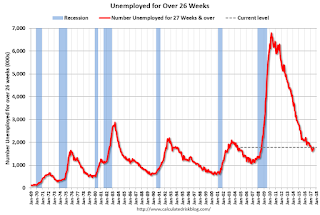by Calculated Risk on 8/04/2017 10:00:00 AM
Friday, August 04, 2017
Comment: A Solid Employment Report
The headline jobs number was above expectations, and there were slight combined upward revisions to the previous two months. And the unemployment decreased slightly.
Earlier: July Employment Report: 209,000 Jobs, 4.3% Unemployment Rate
In July, the year-over-year change was 2.16 million jobs. This is decent year-over-year job growth.
Note that July has been the second strongest month for job growth over the three previous years, exceeded only by June, and just ahead of November. This is the 4th consecutive solid job gain in July: 202 thousand in July 2014, 254 in July 2015, 291 thousand in July 2016, and now 209 thousand in July 2017.
Average Hourly Earnings

This graph is based on “Average Hourly Earnings” from the Current Employment Statistics (CES) (aka "Establishment") monthly employment report. Note: There are also two quarterly sources for earnings data: 1) “Hourly Compensation,” from the BLS’s Productivity and Costs; and 2) the Employment Cost Index which includes wage/salary and benefit compensation.
The graph shows the nominal year-over-year change in "Average Hourly Earnings" for all private employees. Nominal wage growth was at 2.5% YoY in July.
Wage growth has generally been trending up.
Part Time for Economic Reasons

The number of persons employed part time for economic reasons (sometimes referred to as involuntary part-time workers), at 5.3 million, was essentially unchanged in July. These individuals, who would have preferred full-time employment, were working part time because their hours had been cut back or because they were unable to find a full-time job.The number of persons working part time for economic reasons decreased slightly in July. The number working part time for economic reasons suggests a little slack still in the labor market.
These workers are included in the alternate measure of labor underutilization (U-6) that was unchanged at 8.6% in July.
Unemployed over 26 Weeks
 This graph shows the number of workers unemployed for 27 weeks or more.
This graph shows the number of workers unemployed for 27 weeks or more. According to the BLS, there are 1.79 million workers who have been unemployed for more than 26 weeks and still want a job. This was up from 1.66 million in June.
This is generally trending down, but still a little elevated.
Although U-6, the number of persons employed part time for economic reasons, and the number of long term unemployed are still a little elevated, it appears the economy is nearing full employment.
Overall this was another solid report.


